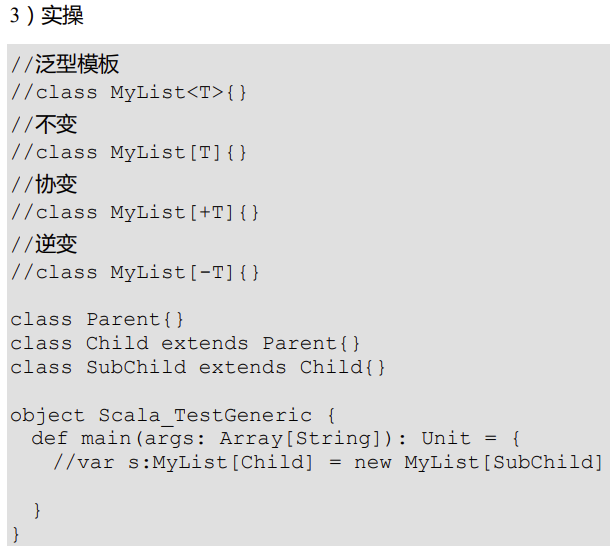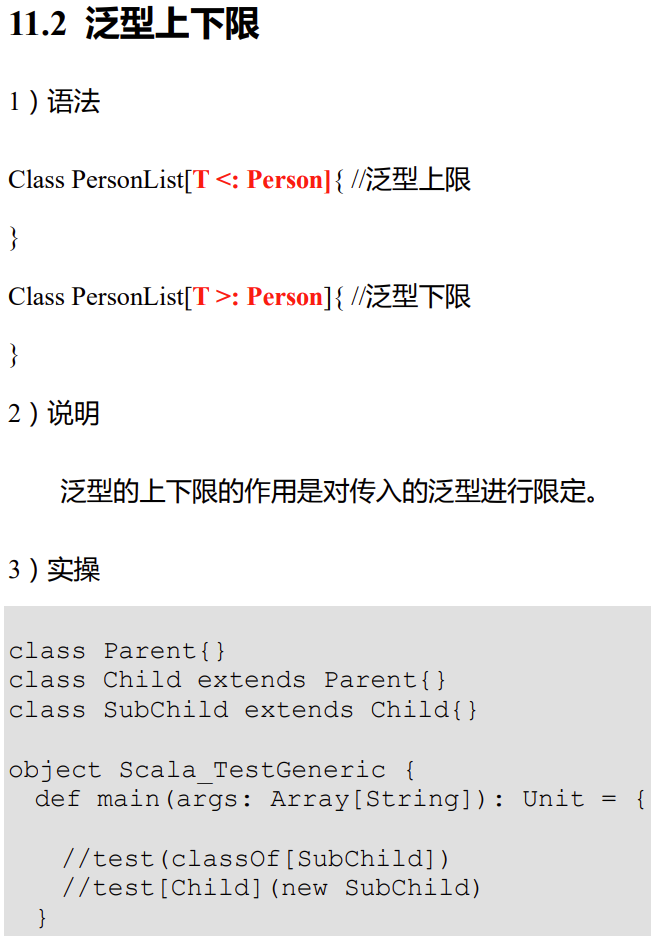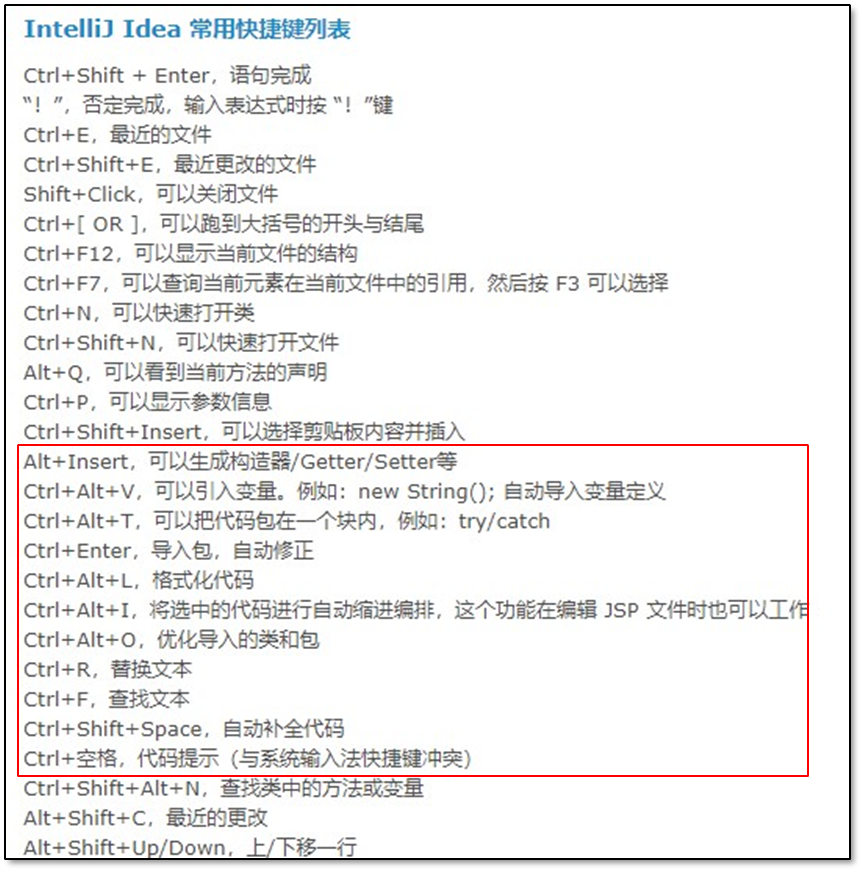尚硅谷大数据技术Scala教程-笔记05【模式匹配、异常、隐式转换、泛型、scala总结】

视频地址:尚硅谷大数据技术之Scala入门到精通教程(小白快速上手scala)_哔哩哔哩_bilibili
目录
第08章-模式匹配
P125【125_尚硅谷_Scala_模式匹配(一)_基本概念和用法】10:47
P126【126_尚硅谷_Scala_模式匹配(二)_模式守卫】04:22
P127【127_尚硅谷_Scala_模式匹配(三)_模式匹配的不同用法(一)_匹配常量】06:03
P128【128_尚硅谷_Scala_模式匹配(三)_模式匹配的不同用法(二)_匹配类型】07:12
P129【129_尚硅谷_Scala_模式匹配(三)_模式匹配的不同用法(三)_匹配数组】07:59
P130【130_尚硅谷_Scala_模式匹配(三)_模式匹配的不同用法(四)_匹配列表】08:56
P131【131_尚硅谷_Scala_模式匹配(三)_模式匹配的不同用法(五)_匹配元组(一)_基本用法】06:20
P132【132_尚硅谷_Scala_模式匹配(三)_模式匹配的不同用法(五)_匹配元组(二)_变量声明】05:49
P133【133_尚硅谷_Scala_模式匹配(三)_模式匹配的不同用法(五)_匹配元组(三)_for推导式中变量】07:30
P134【134_尚硅谷_Scala_模式匹配(三)_模式匹配的不同用法(六)_匹配对象】10:15
P135【135_尚硅谷_Scala_模式匹配(三)_模式匹配的不同用法(七)_样例类】04:04
P136【136_尚硅谷_Scala_模式匹配(四)_偏函数】15:50
第09章-异常
P137【137_尚硅谷_Scala_异常处理】08:14
第10章-隐式转换
P138【138_尚硅谷_Scala_隐式转换(一)_基本概念和类型】06:54
P139【139_尚硅谷_Scala_隐式转换(二)_隐式函数和隐式类】07:57
P140【140_尚硅谷_Scala_隐式转换(三)_隐式参数】09:38
第11章-泛型
P141【141_尚硅谷_Scala_泛型(一)_概念和意义】05:56
P142【142_尚硅谷_Scala_泛型(二)_逆变和协变】06:40
P143【143_尚硅谷_Scala_泛型(三)_上下限】06:14
第12章-总结
第13章-IDEA快捷键
第08章-模式匹配
P125【125_尚硅谷_Scala_模式匹配(一)_基本概念和用法】10:47
package chapter08object Test01_PatternMatchBase {def main(args: Array[String]): Unit = {// 1. 基本定义语法val x: Int = 5val y: String = x match {case 1 => "one"case 2 => "two"case 3 => "three"case _ => "other"}println(y) //other// 2. 示例:用模式匹配实现简单二元运算val a = 25val b = 13def matchDualOp(op: Char): Int = op match {case '+' => a + bcase '-' => a - bcase '*' => a * bcase '/' => a / bcase '%' => a % bcase _ => -1}println(matchDualOp('+')) //38println(matchDualOp('/')) //1println(matchDualOp('\\\\')) //-1}
}P126【126_尚硅谷_Scala_模式匹配(二)_模式守卫】04:22
package chapter08object Test01_PatternMatchBase {def main(args: Array[String]): Unit = {// 3. 模式守卫def abs(num: Int): Int = {//求一个整数的绝对值num match {case i if i >= 0 => icase i if i < 0 => -i}}println(abs(67)) //67println(abs(0)) //0println(abs(-24)) //24}
}P127【127_尚硅谷_Scala_模式匹配(三)_模式匹配的不同用法(一)_匹配常量】06:03
Scala中,模式匹配可以匹配所有的字面量,包括字符串,字符,数字,布尔值等等。
package chapter08object Test02_MatchTypes {def main(args: Array[String]): Unit = {// 1. 匹配常量def describeConst(x: Any): String = x match {case 1 => "Int one"case "hello" => "String hello"case true => "Boolean true"case '+' => "Char +"case _ => "~"}println(describeConst("hello")) //String helloprintln(describeConst('+')) //Char +println(describeConst(0.3)) //~}
}P128【128_尚硅谷_Scala_模式匹配(三)_模式匹配的不同用法(二)_匹配类型】07:12
// 2. 匹配类型def describeType(x: Any): String = x match {case i: Int => "Int " + icase s: String => "String " + scase list: List[String] => "List " + listcase array: Array[Int] => "Array[Int] " + array.mkString(",")case a => "Something else: " + a}println(describeType(35)) //Int 35println(describeType("hello")) //String helloprintln(describeType(List("hi", "hello"))) //List List(hi, hello)println(describeType(List(2, 23))) //List List(2, 23)println(describeType(Array("hi", "hello"))) //Something else: [Ljava.lang.String;@75bd9247println(describeType(Array(2, 23))) //Array[Int] 2,23P129【129_尚硅谷_Scala_模式匹配(三)_模式匹配的不同用法(三)_匹配数组】07:59
// 3. 匹配数组for (arr <- List(Array(0),Array(1, 0),Array(0, 1, 0),Array(1, 1, 0),Array(2, 3, 7, 15),Array("hello", 1, 30),)) {val result = arr match {case Array(0) => "0"case Array(1, 0) => "Array(1, 0)"case Array(x, y) => "Array: " + x + ", " + y //匹配两元素数组case Array(0, _*) => "以0开头的数组"case Array(x, 1, z) => "中间为1的三元素数组"case _ => "something else"}println(result)}P130【130_尚硅谷_Scala_模式匹配(三)_模式匹配的不同用法(四)_匹配列表】08:56
// 4. 匹配列表// 方式一for (list <- List(List(0),List(1, 0),List(0, 0, 0),List(1, 1, 0),List(88),List("hello"))) {val result = list match {case List(0) => "0"case List(x, y) => "List(x, y): " + x + ", " + ycase List(0, _*) => "List(0, ...)"case List(a) => "List(a): " + acase _ => "something else"}println(result)}// 方式二val list1 = List(1, 2, 5, 7, 24)val list = List(24)list match {case first :: second :: rest => println(s"first: $first, second: $second, rest: $rest")case _ => println("something else")}P131【131_尚硅谷_Scala_模式匹配(三)_模式匹配的不同用法(五)_匹配元组(一)_基本用法】06:20
// 5. 匹配元组for (tuple <- List((0, 1),(0, 0),(0, 1, 0),(0, 1, 1),(1, 23, 56),("hello", true, 0.5))) {val result = tuple match {case (a, b) => "" + a + ", " + bcase (0, _) => "(0, _)"case (a, 1, _) => "(a, 1, _) " + acase (x, y, z) => "(x, y, z) " + x + " " + y + " " + zcase _ => "something else"}println(result)}P132【132_尚硅谷_Scala_模式匹配(三)_模式匹配的不同用法(五)_匹配元组(二)_变量声明】05:49
package chapter08object Test03_MatchTupleExtend {def main(args: Array[String]): Unit = {// 1. 在变量声明时匹配val (x, y) = (10, "hello")println(s"x: $x, y: $y")val List(first, second, _*) = List(23, 15, 9, 78)println(s"first: $first, second: $second")val fir :: sec :: rest = List(23, 15, 9, 78)println(s"first: $fir, second: $sec, rest: $rest")}
}P133【133_尚硅谷_Scala_模式匹配(三)_模式匹配的不同用法(五)_匹配元组(三)_for推导式中变量】07:30
package chapter08object Test03_MatchTupleExtend {def main(args: Array[String]): Unit = {println("=====================1. 在变量声明时匹配")// 1. 在变量声明时匹配val (x, y) = (10, "hello")println(s"x: $x, y: $y")val List(first, second, _*) = List(23, 15, 9, 78)println(s"first: $first, second: $second")val fir :: sec :: rest = List(23, 15, 9, 78)println(s"first: $fir, second: $sec, rest: $rest")println("=====================2. for推导式中进行模式匹配")// 2. for推导式中进行模式匹配val list: List[(String, Int)] = List(("a", 12), ("b", 35), ("c", 27), ("a", 13))// 2.1 原本的遍历方式for (elem <- list) {println(elem._1 + " " + elem._2)}println("-----------------------")// 2.2 将List的元素直接定义为元组,对变量赋值for ((word, count) <- list) {println(word + ": " + count)}println("-----------------------")// 2.3 可以不考虑某个位置的变量,只遍历key或者valuefor ((word, _) <- list)println(word)println("-----------------------")// 2.4 可以指定某个位置的值必须是多少for (("a", count) <- list) {println(count)}}
}P134【134_尚硅谷_Scala_模式匹配(三)_模式匹配的不同用法(六)_匹配对象】10:15
package chapter08object Test04_MatchObject {def main(args: Array[String]): Unit = {val student = new Student("alice", 18)//针对对象实例的内容进行匹配val result = student match {case Student("alice", 18) => "alice, 18"case _ => "Else"}println(result)}
}//定义类
class Student(val name: String, val age: Int)//定义伴生对象
object Student {def apply(name: String, age: Int): Student = new Student(name, age)//必须实现一个unapply方法,用来对对象属性进行拆解def unapply(student: Student): Option[(String, Int)] = {if (student == null) {None} else {Some((student.name, student.age))}}
}P135【135_尚硅谷_Scala_模式匹配(三)_模式匹配的不同用法(七)_样例类】04:04
package chapter08object Test05_MatchCaseClass {def main(args: Array[String]): Unit = {val student = Student1("alice", 18)//针对对象实例的内容进行匹配val result = student match {case Student1("alice", 18) => "Alice, 18"case _ => "Else"}println(result) //Alice, 18}
}//定义样例类
case class Student1(name: String, age: Int)P136【136_尚硅谷_Scala_模式匹配(四)_偏函数】15:50
package chapter08object Test06_PartialFunction {def main(args: Array[String]): Unit = {val list: List[(String, Int)] = List(("a", 12), ("b", 35), ("c", 27), ("a", 13))// 1. map转换,实现key不变,value2倍val newList = list.map(tuple => (tuple._1, tuple._2 * 2))// 2. 用模式匹配对元组元素赋值,实现功能val newList2 = list.map(tuple => {tuple match {case (word, count) => (word, count * 2)}})// 3. 省略lambda表达式的写法,进行简化val newList3 = list.map {case (word, count) => (word, count * 2)}println(newList) //List((a,24), (b,70), (c,54), (a,26))println(newList2) //List((a,24), (b,70), (c,54), (a,26))println(newList3) //List((a,24), (b,70), (c,54), (a,26))// 偏函数的应用,求绝对值// 对输入数据分为不同的情形:正、负、0val positiveAbs: PartialFunction[Int, Int] = {case x if x > 0 => x}val negativeAbs: PartialFunction[Int, Int] = {case x if x < 0 => -x}val zeroAbs: PartialFunction[Int, Int] = {case 0 => 0}def abs(x: Int): Int = (positiveAbs orElse negativeAbs orElse zeroAbs) (x)println(abs(-67)) //67println(abs(35)) //35println(abs(0)) //0}
}第09章-异常
P137【137_尚硅谷_Scala_异常处理】08:14
package chapter09plusobject Test01_Exception {def main(args: Array[String]): Unit = {try {val n = 10 / 0} catch {case e: ArithmeticException => {println("发生算术异常!")}case e: Exception => {println("发生一般异常!")}} finally {println("处理结束!")}}
}第10章-隐式转换
P138【138_尚硅谷_Scala_隐式转换(一)_基本概念和类型】06:54
当编译器第一次编译失败的时候,会在当前的环境中查找能让代码编译通过的方法,用于将类型进行转换,实现二次编。
P139【139_尚硅谷_Scala_隐式转换(二)_隐式函数和隐式类】07:57
package chapter09plusobject Test02_Implicit {def main(args: Array[String]): Unit = {val new12 = new MyRichInt(12)println(new12.myMax(15))// 1. 隐式函数implicit def convert(num: Int): MyRichInt = new MyRichInt(num)println(12.myMax(15))println("============================")// 2. 隐式类implicit class MyRichInt2(val self: Int) {// 自定义比较大小的方法def myMax2(n: Int): Int = if (n < self) self else ndef myMin2(n: Int): Int = if (n < self) n else self}println(12.myMin2(15))println("============================")// 3. 隐式参数implicit val str: String = "alice"// implicit val str2: String = "alice2"implicit val num: Int = 18def sayHello()(implicit name: String): Unit = {println("hello, " + name)}def sayHi(implicit name: String = "atguigu"): Unit = {println("hi, " + name)}sayHellosayHi// 简便写法def hiAge(): Unit = {println("hi, " + implicitly[Int])}hiAge()}
}// 自定义类
class MyRichInt(val self: Int) {// 自定义比较大小的方法def myMax(n: Int): Int = if (n < self) self else ndef myMin(n: Int): Int = if (n < self) n else self
}P140【140_尚硅谷_Scala_隐式转换(三)_隐式参数】09:38
package chapter09plusobject Test02_Implicit {def main(args: Array[String]): Unit = {// 3. 隐式参数implicit val str: String = "alice"// implicit val str2: String = "alice2"implicit val num: Int = 18def sayHello()(implicit name: String): Unit = {println("hello, " + name)}def sayHi(implicit name: String = "atguigu"): Unit = {println("hi, " + name)}sayHellosayHi// 简便写法def hiAge(): Unit = {println("hi, " + implicitly[Int])}hiAge()}
}
第11章-泛型
P141【141_尚硅谷_Scala_泛型(一)_概念和意义】05:56
P142【142_尚硅谷_Scala_泛型(二)_逆变和协变】06:40
package chapter09plusobject Test03_Generics {def main(args: Array[String]): Unit = {// 1. 协变和逆变val child: Parent = new Child//val childList: MyCollection[Parent] = new MyCollection[Child]val childList: MyCollection[SubChild] = new MyCollection[Child]}
}// 定义继承关系
class Parent {}class Child extends Parent {}class SubChild extends Child {}// 定义带泛型的集合类型
class MyCollection[-E] {}P143【143_尚硅谷_Scala_泛型(三)_上下限】06:14
package chapter09plusobject Test03_Generics {def main(args: Array[String]): Unit = {// 2. 上下限def test[A <: Child](a: A): Unit = {println(a.getClass.getName)}test[SubChild](new SubChild)}
}// 定义继承关系
class Parent {}class Child extends Parent {}class SubChild extends Child {}// 定义带泛型的集合类型
class MyCollection[-E] {}第12章-总结
12.1 开发环境
要求掌握必要的 Scala 开发环境搭建技能。
12.2 变量和数据类型
掌握 var 和 val 的区别掌握数值类型(Byte、Short、Int、Long、Float、Double、Char)之间的转换关系
12.3 流程控制
掌握 if-else、for、while 等必要的流程控制结构,掌握如何实现 break、continue 的功能。
12.4 函数式编程
掌握高阶函数、匿名函数、函数柯里化、闭包、函数参数以及函数至简原则。
12.5 面向对象
掌握 Scala 与 Java 继承方面的区别、单例对象(伴生对象)、构造方法、特质的用法及功能。
12.6 集合
掌握常用集合的使用、集合常用的计算函数。
12.7 模式匹配
掌握模式匹配的用法
12.8 下划线
掌握下划线不同场合的不同用法
12.9 异常
掌握异常常用操作即可
12.10 隐式转换
掌握隐式方法、隐式参数、隐式类,以及隐式解析机制
12.11 泛型
掌握泛型语法









